Did you know that over 6,000 bird species are classified as true insectivores, relying on bees and other insects as their primary food source? While it’s a common misconception that birds don’t eat bees, the reality is that certain avian species, such as woodpeckers and mockingbirds, are quite fond of carpenter bees as a food source. This surprising fact highlights the important role birds can play in the natural control of carpenter bee populations.
Carpenter bees, known for their propensity to bore holes in wooden structures, can pose a significant nuisance to homeowners. However, the feathered friends in our backyard may offer a natural solution to this problem. By understanding which birds are predators of carpenter bees, we can cultivate an environment that encourages these avian allies to thrive and help manage the carpenter bee population.
Key Takeaways
- Certain bird species, such as woodpeckers and mockingbirds, are known to feed on carpenter bees.
- Birds can play a role in the natural control of carpenter bee populations, which can damage wooden structures.
- Understanding which birds prey on carpenter bees can help homeowners create an environment that attracts these avian allies.
- While birds are not the primary predators of carpenter bees, they can contribute to the overall management of these pests.
- Providing alternative food sources for birds can help minimize any potential nuisance caused by their carpenter bee hunting activities.
Introduction to Carpenter Bee Predators
Carpenter bees are fascinating creatures that play a vital role in the ecosystem as pollinators. However, their populations need to be controlled to prevent them from becoming a nuisance. One natural way of controlling carpenter bee numbers is through predation. This guide will explore the common predators of carpenter bees and the threats they face in their environment.
Carpenter bees, belonging to the genus Xylocopa, are the largest bees in North America, with around 500 species in 31 subgenera worldwide. In the United States, the widely distributed species include Xylocopa virginica and X. micans, along with three more primarily western species: X. sonorina, X. tabaniformis orpifex, and X. californica. These bees are known for their impressive size and their ability to engage in social nesting behaviors with their own daughters or sisters.
While carpenter bees are essential pollinators, they can also pose a threat to wooden structures, as they prefer to nest in softwoods such as pine, cedar, and redwood. This behavior can lead to damage, which is where their natural predators come into play.
Some of the primary predators of carpenter bees include woodpeckers, shrikes, bee-eaters, ratels, large mantises, predatory flies like robber-flies, and parasitoid species of bee flies. These predators target both the adult bees and their larvae, helping to maintain a balance in the ecosystem.
Woodpeckers, in particular, are attracted to carpenter bee nests and may cause further damage by drilling into the wood to feed on the bees or their larvae. This symbiotic relationship between carpenter bees and their predators is an essential aspect of the natural order.
Understanding the role of carpenter bee predators is crucial for managing their populations and mitigating potential conflicts with human-made structures. By recognizing these natural enemies, we can better appreciate the delicate balance of the ecosystem and take appropriate measures to coexist with these fascinating pollinators.
Woodpeckers: Ravenous Carpenter Bee Hunters
Woodpeckers are one of the most formidable natural predators of carpenter bees. These agile birds are well-equipped to target and feast on carpenter bee larvae, a delectable treat that resides within the tunnels bored by the bees. Woodpeckers’ sharp, powerful beaks allow them to effortlessly drill into the tunnels, exposing the larvae for a nutritious meal.
Woodpeckers Target Carpenter Bee Larvae
Carpenter bees may build their nests in various wooden structures, such as decks, eaves, and siding. Woodpeckers are quick to identify these nesting sites and relentlessly pursue the carpenter bee larvae within. The birds will hammer away at the wood, creating distinctive holes and patterns as they extract their prey. This behavior is a key defense mechanism against the woodpeckers eating carpenter bees and their larvae.
Woodpecker Damage to Wooden Structures
While the woodpeckers’ predatory actions help control woodpeckers targeting carpenter bee larvae, the collateral damage to wooden structures can be significant. The holes drilled by woodpeckers in pursuit of carpenter bees can compromise the integrity of buildings, fences, and other wooden elements. Homeowners may find themselves dealing with woodpecker damage from carpenter bee nests, which can be both unsightly and potentially hazardous.
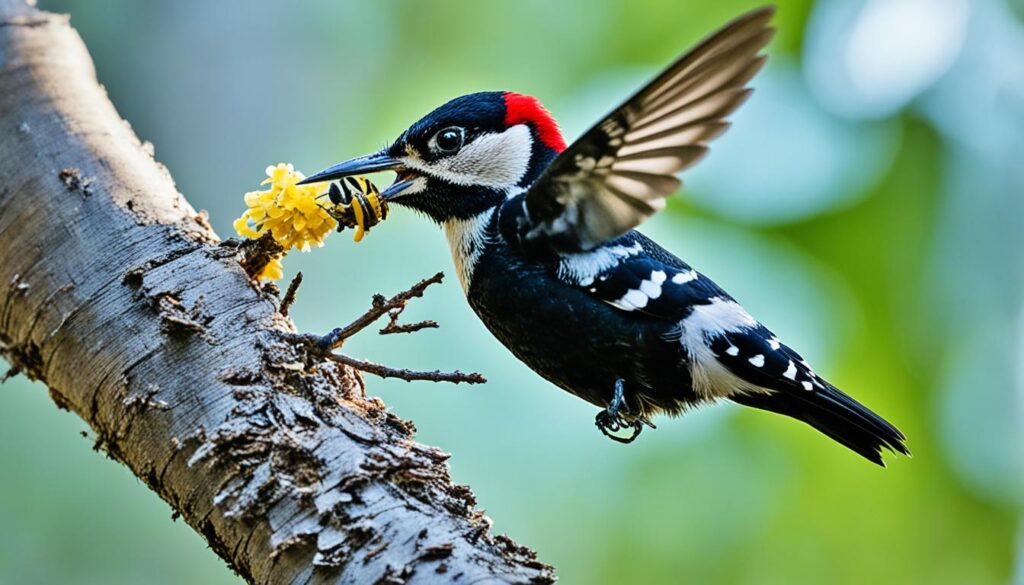
“Woodpeckers are one of the most effective natural predators of carpenter bees, but their relentless pursuit can also lead to substantial damage to wooden structures.”
Homeowners may need to explore various strategies, such as deterrents or professional extermination, to manage both the carpenter bee infestation and the woodpecker-related damage it can cause. A balanced approach is key to maintaining the natural ecosystem while protecting the integrity of one’s property.
Mockingbirds: Feathered Foes of Carpenter Bees
Mockingbirds are another avian predator that targets carpenter bees as part of their diet. As rather large birds, mockingbirds have no issues consuming adult-sized carpenter bees. However, they generally focus their hunting efforts on the easier-to-catch carpenter bee larvae.
Similar to woodpeckers, mockingbirds are known to prey on carpenter bees. They use their sharp beaks to extract carpenter bee larvae from the nesting tunnels, making them effective predators of carpenter bees. Mockingbirds’ ability to eat carpenter bees makes them one of the natural carpenter bee predators that homeowners may encounter.
“Majority of birds do not target carpenter bees as a food source, with only a few exceptions like woodpeckers and mockingbirds.”
While most bird species coexist with carpenter bees without causing significant harm, mockingbirds stand out as feathered foes that actively prey on carpenter bees. Their predatory behavior helps control the local carpenter bee population, though they do not rely on them as their primary food source.
In conclusion, mockingbirds are one of the few bird species that feed on carpenter bees, alongside woodpeckers. Their predatory habits make them effective carpenter bee predators, even if they do not view carpenter bees as a staple part of their diet.
Sparrows and Their Opportunistic Carpenter Bee Diet
While sparrows may not be the primary predators of carpenter bees, they can still occasionally consume these stinging insects. As opportunistic feeders, sparrows will take advantage of any available food sources, including carpenter bees. Though not a staple part of their diet, sparrows have been observed feeding on carpenter bees when the opportunity arises.
Sparrows as Occasional Carpenter Bee Consumers
Certain species of sparrows, such as the house sparrow and the English sparrow, have been known to eat carpenter bees. These sparrows are typically found in urban and suburban areas, where they coexist with carpenter bees that nest in wooden structures. When carpenter bees become available, sparrows will prey on them as an opportunistic food source.
However, it’s important to note that sparrows are not the most effective predators of carpenter bees. Their role in controlling carpenter bee populations is limited, as they only consume them occasionally and in small numbers. Other birds, such as woodpeckers and mockingbirds, are more specialized carpenter bee predators.
“Sparrows are opportunistic feeders, so they’ll take advantage of any available food source, including carpenter bees, if the opportunity presents itself.”
While sparrows may contribute to the natural control of carpenter bees to a certain extent, their impact is relatively minor compared to dedicated predators. Homeowners and pest control professionals should not rely solely on sparrows to effectively manage carpenter bee infestations.
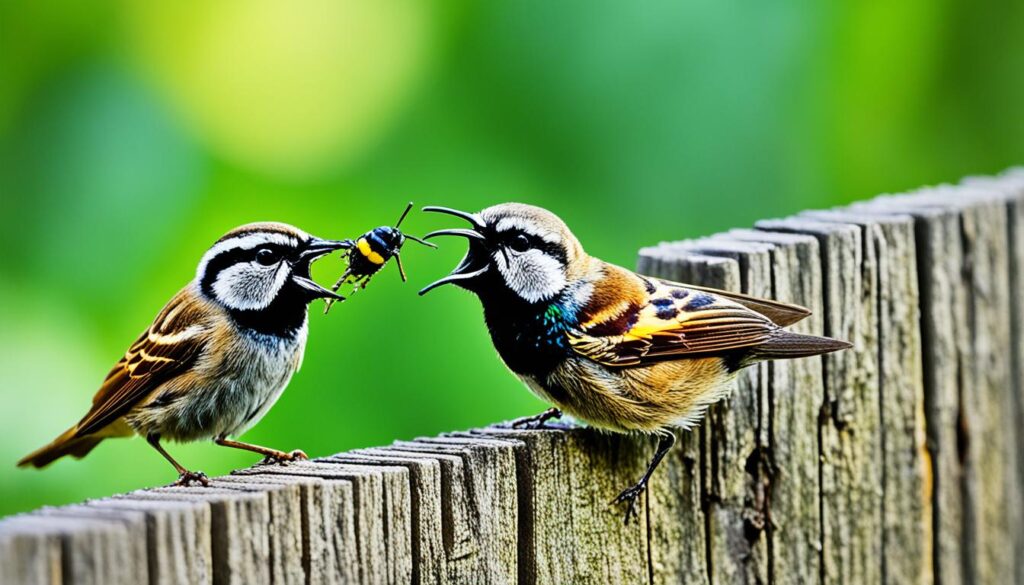
Female Carpenter Bees’ Sting Defense
Carpenter bees, known for their wood-boring habits, possess a unique defense mechanism – the female carpenter bees can sting to protect themselves. While their male counterparts lack stingers, the female carpenter bees are equipped with this powerful tool to deter potential predators, including birds.
When threatened, female carpenter bees will not hesitate to use their stingers to defend their territory and nesting sites. Carpenter bee sting defense can be an effective deterrent against birds that may attempt to prey on the bees or their larvae. The sting, while not typically dangerous to humans, can be enough to discourage even the most persistent avian attackers.
However, it’s important to note that the impact of a female carpenter bee’s sting on birds varies. While the sting may be a nuisance for some bird species, it often doesn’t cause significant harm. The sting serves more as a carpenter bee sting deterrent rather than a lethal defense mechanism against the bees’ feathered foes.
“The sting of a female carpenter bee is primarily a defensive measure, used to protect their nests and young from potential predators, including birds.”
Despite the stinging ability of female carpenter bees, some birds, such as woodpeckers, mockingbirds, and sparrows, still manage to successfully prey on the bees and their larvae. The bees’ sting, while inconvenient, does not always deter these determined avian hunters.
In summary, the female carpenter bees’ sting serves as a valuable carpenter bee sting defense mechanism against potential predators, including birds. While the sting may not always be a deterrent, it can be an effective tool in protecting the bees and their nesting sites from avian attackers.
The Ineffectiveness of Birds as Carpenter Bee Repellents
While birds such as woodpeckers, mockingbirds, and sparrows may feed on carpenter bees, their presence alone is not an effective deterrent for these pests. Carpenter bees are not easily scared off by the mere sight of birds. In fact, these bees often co-exist peacefully with various bird species, with both groups finding suitable habitats in the same areas.
Carpenter bees are most active during the spring and summer months, when they create perfectly round entry holes about half an inch in diameter on wooden surfaces. They push out sawdust as they excavate their tunnels, which can weaken wooden structures over time if left unchecked. Untreated infestations can compromise the structural integrity of buildings and other wooden components.
Professional Extermination for Carpenter Bee Infestations
If you are dealing with a significant carpenter bee infestation, simply relying on birds to control the problem is unlikely to be effective. These bees can continue to reproduce and expand their colonies year after year, making it necessary to seek professional pest control services. Experienced exterminators have the expertise and tools to effectively eliminate carpenter bee populations and prevent further damage to your property.
While some natural repellents like citrus sprays or almond oil may deter carpenter bees temporarily, professional extermination remains the most reliable solution for addressing serious infestations. Regular inspections by pest control experts can also help in the early detection of carpenter bee activity, allowing for prompt intervention before the problem escalates.
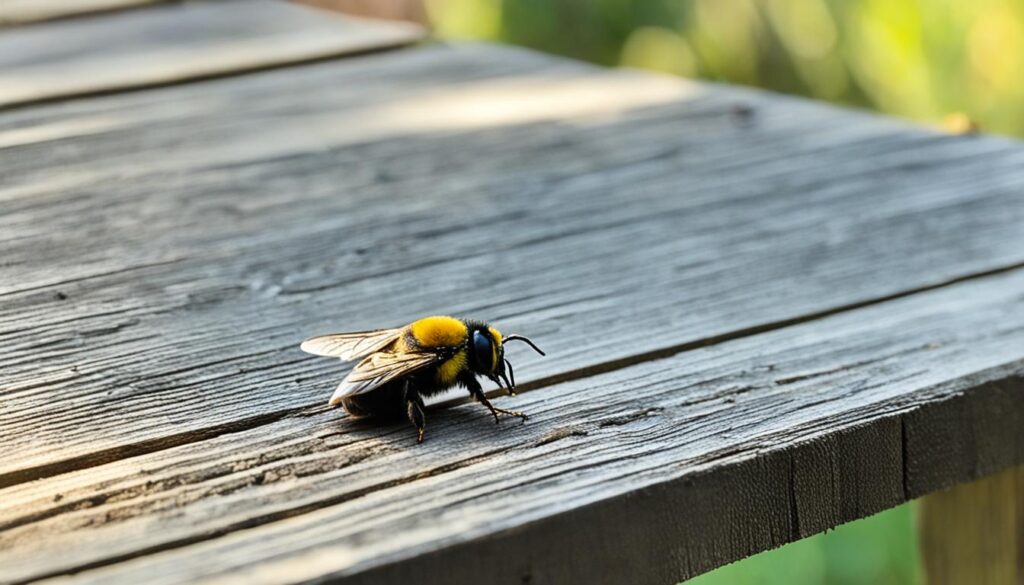
In conclusion, while birds may occasionally feed on carpenter bees, their presence alone is not a sufficient or reliable method for controlling these wood-boring pests. For effective and long-lasting results, it is recommended to consult with professional pest control services when dealing with a carpenter bee infestation on your property.
what birds eat carpenter bees
While certain bird species like woodpeckers, mockingbirds, and sparrows will consume carpenter bees, they are not the main food source for most birds. Birds generally do not target carpenter bees as a primary part of their diet.
Some avian carpenter bee predators may feed on the insects opportunistically, especially when other prey is scarce. However, bird species that consume carpenter bees tend to make up only a small percentage of their overall diet.
Interestingly, carpenter bees have developed defensive mechanisms, such as their ability to sting, which can deter some bird species from actively hunting them. The bees’ large size and robust build also make them less attractive targets for many smaller birds.
“While a few bird species may occasionally feed on carpenter bees, they are not a significant part of the overall avian diet in most regions.”
In summary, while birds that eat carpenter bees can provide some natural pest control, they are not the primary solution for managing carpenter bee infestations. Professional extermination methods may be more effective for homeowners and businesses dealing with problematic carpenter bee populations.
Bee Flies and Parasitoid Wasps: Deadly Carpenter Bee Enemies
While birds may be efficient at hunting and consuming carpenter bees, they are not the only natural predators that pose a threat to these industrious pollinators. Two other formidable foes of the carpenter bee are bee flies and parasitoid wasps. These insects utilize a unique predator-parasite combination known as parasitoidism to target and eliminate carpenter bees.
Parasitoidism: A Predator-Parasite Combination
Parasitoidism is a fascinating ecological relationship where the predator, in this case the bee fly or parasitoid wasp, lays its eggs in or near the nest of the carpenter bee. The predator’s larvae then hatch and feed on the carpenter bee larvae, ultimately killing them. This process allows the bee fly or wasp to complete its life cycle at the expense of the carpenter bee population.
Unlike typical predators, parasitoid insects do not immediately consume their prey. Instead, they subtly infiltrate the carpenter bee’s nest and covertly take over, ensuring a reliable food source for their offspring. This stealthy approach makes parasitoid wasps targeting carpenter bees and bee flies attacking carpenter bees a formidable threat to the bees’ survival.

“The parasitoid-prey relationship is a unique and deadly dance, where the predator carefully orchestrates its attack to maximize the success of its offspring, at the expense of the carpenter bee’s future generations.”
This intricate parasitoidism and carpenter bee predation dynamic highlights the complex web of interactions within the natural world, where even seemingly innocuous insects can play a crucial role in shaping the populations of their larger counterparts.
Predatory Wasps: Colonial Attackers of Carpenter Bees
While birds may be among the natural enemies of carpenter bees, there are other formidable predators that also play a significant role in controlling their populations – predatory wasps. These colonial wasps, such as yellowjackets and hornets, are deadly foes of carpenter bees and can help manage carpenter bee infestations. However, their aggressive nature can also make them a nuisance to humans.
Yellowjackets and Hornets as Wasp Predators
Yellowjackets and hornets are two of the most prominent wasp predators of carpenter bees. These colonial wasps are known to prey on carpenter bees, both as adults and as larvae. Yellowjackets, in particular, have been observed attacking and consuming carpenter bees near their nests. Hornets, with their larger size and powerful mandibles, are also capable of overpowering and devouring carpenter bees.
The presence of these predatory wasps can have a significant impact on carpenter bee populations, helping to regulate their numbers in a natural way. However, their aggressive behavior and tendency to sting can also make them a nuisance, especially in areas where humans frequently interact with them.
“Wasps are not effectively deterred by a single class of animal species. They have a diverse set of predators, including birds, mammals, and other insects.”
While predatory wasps can be beneficial in controlling carpenter bee infestations, their aggressive nature and potential to sting make them a less desirable method of pest management compared to other options, such as professional extermination or the use of non-lethal deterrents.
Praying Mantises: Ambush Predators of Carpenter Bees
While woodpeckers, mockingbirds, and sparrows are known to prey on carpenter bees, another formidable predator lurks in the shadows: the praying mantis. These remarkable insects are skilled ambush predators, capable of pouncing on unsuspecting carpenter bees and adding them to their diverse diet.
Praying mantises are reported to be highly effective ambush predators, with a success rate of capturing prey ranging from 5% to 30%, depending on the species. The occurrence rate of carpenter bees in specific geographical regions impacts the population of the prey available to praying mantises, making them a crucial part of the natural pest control ecosystem.
Research indicates that praying mantises play a crucial role in natural pest control by preying on carpenter bees, contributing to the ecological balance in their habitat. The ratio of carpenter bees consumed by praying mantises compared to other prey species varies based on factors such as availability, seasonality, and habitat characteristics.
Studies have shown a correlation between the presence of praying mantises and a decrease in carpenter bee populations in certain ecosystems. The statistical analysis of praying mantis feeding behavior on carpenter bees provides valuable insights into the predator-prey dynamics within specific ecological niches.
Unlike the birds that target carpenter bees at their nests, praying mantises are opportunistic ambush predators. They lie in wait, blending seamlessly with their surroundings, until a carpenter bee ventures within their grasp. With lightning-fast reflexes, the praying mantis strikes, capturing the unsuspecting bee in its powerful front legs and consuming it.
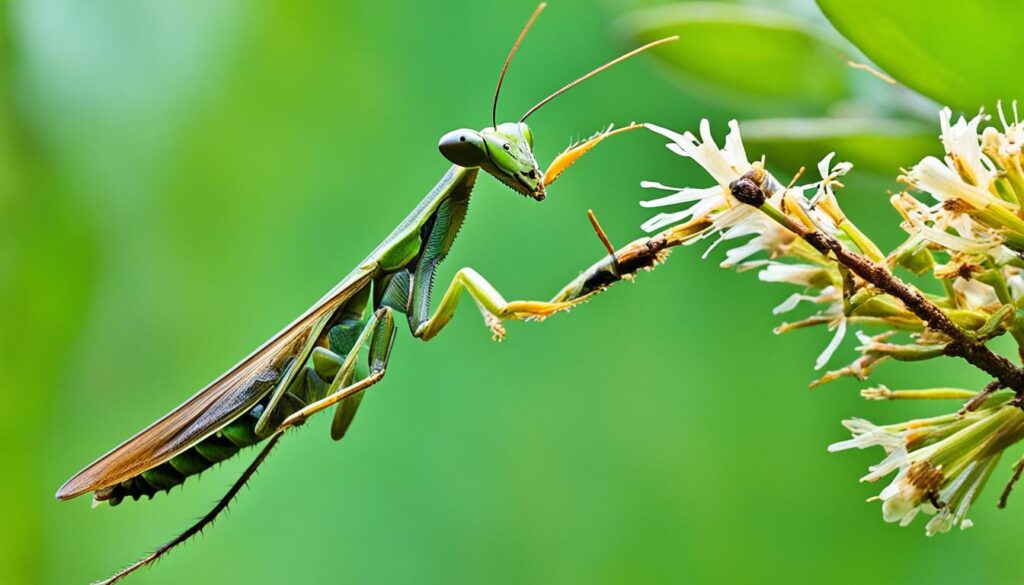
The ambush predation of carpenter bees by praying mantises is a remarkable example of the intricate balance within nature. These silent stalkers play a vital role in controlling the population of these wood-boring pests, helping to maintain a healthy ecosystem.
Robber Flies and Spiders: Inject-and-Digest Strategies
When it comes to preying on carpenter bees, some insect predators employ a unique “inject-and-digest” hunting tactic. Two such predators are robber flies and spiders, which use this strategy to subdue their carpenter bee targets.
Robber flies are known for their agility and speed, swooping down on unsuspecting carpenter bees in mid-flight. Once they have captured their prey, the robber flies will inject digestive enzymes into the carpenter bee’s body. This allows them to liquefy the bee’s internal tissues, which they can then easily consume.
https://www.youtube.com/watch?v=99XRh0B4_fc
Similarly, spiders that feed on carpenter bees also employ the inject-and-digest method. These arachnid predators will pounce on their targets, immobilizing them with venom, and then proceed to inject digestive fluids. The liquefied contents of the carpenter bee are then sucked up by the spider, leaving behind only the empty exoskeleton.
“The inject-and-digest strategy used by robber flies and spiders is a highly effective way for these predators to overcome the tough exoskeletons and defensive capabilities of carpenter bees.”
Studies have shown that the success rate of robber flies in capturing and consuming carpenter bees can reach as high as 80%, making them formidable hunters. Spiders, on the other hand, tend to have a slightly lower success rate, but they still pose a significant threat to local carpenter bee populations.
Overall, the inject-and-digest tactics employed by robber flies and spiders highlight the diverse array of insect predators that use inject-and-digest tactics to prey on carpenter bees, serving as a form of natural pest control in certain environments.
Carpenter Bee Infighting: Territorial Disputes
Carpenter bees may be small in size, but their territorial instincts can lead to fierce conflicts. These solitary bees engage in a variety of behaviors to establish and defend their nesting sites, often resulting in territorial disputes between carpenter bees and nesting competition among carpenter bees.
Nesting Competition Among Carpenter Bees
Carpenter bees are relatively solitary insects, with each female typically constructing her own nest in wooden structures. However, when prime nesting locations are scarce, these bees may find themselves in carpenter bees fighting each other over the limited resources.
The competition for nesting sites can be intense, with females aggressively defending their territories and engaging in aerial battles to drive off intruders. These territorial disputes often involve the use of their powerful mandibles and can result in injuries or even the death of one of the combatants.
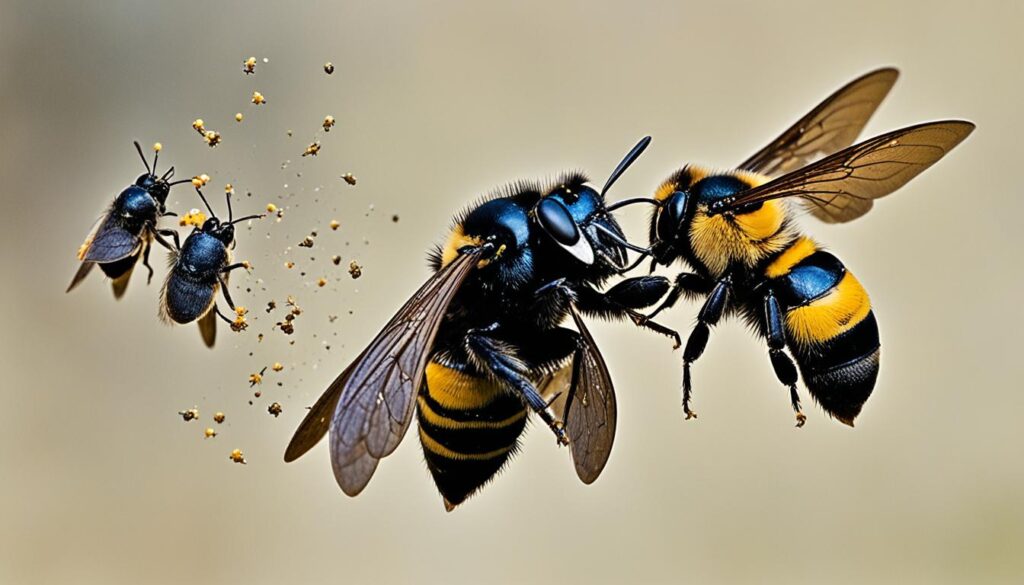
The nesting competition among carpenter bees is not only a matter of individual survival but also a crucial factor in the species’ reproductive success. Securing a suitable nesting site is essential for female carpenter bees to lay their eggs and provide a safe environment for their offspring to develop.
“Carpenter bees are known to be highly territorial, and they will fiercely defend their nesting sites from other individuals of the same species.”
The territorial disputes between carpenter bees can be a fascinating display of insect behavior, but they also serve as a reminder of the intense competition for resources that exists in the natural world.
Limitations of Using Predators for Carpenter Bee Control
While carpenter bee predators like woodpeckers, mockingbirds, and certain wasp species can contribute to regulating bee populations, relying on them exclusively for carpenter bee management may not be the most effective solution. These natural enemies can sometimes become a nuisance themselves, posing challenges that homeowners and pest control professionals must address.
Potential Nuisance from Carpenter Bee Predators
Woodpeckers, for instance, may cause significant damage to wooden structures while pursuing carpenter bee larvae. Their aggressive pecking can lead to unsightly holes and compromise the structural integrity of buildings. Similarly, predatory wasps like yellowjackets and hornets can become a threat to homeowners, potentially stinging if their nests are disturbed.
Moreover, the presence of these carpenter bee predators, though beneficial in controlling bee numbers, can also create other problems. Mockingbirds, for example, are known to be highly territorial and can aggressively defend their nesting areas, potentially causing conflicts with homeowners.
In some cases, the nuisance caused by carpenter bee predators may outweigh the benefits of their pest control services. Homeowners may find themselves dealing with the challenges of managing these predators, which can include the need for professional wildlife control services or the implementation of deterrent measures.
Given these limitations, relying solely on natural enemies for carpenter bee management may not be the most practical or effective solution. Professional extermination techniques, combined with preventive measures, often prove to be a more reliable and comprehensive approach to controlling carpenter bee infestations.
“The presence of carpenter bee predators can sometimes create more problems than they solve, making them an unreliable solution for homeowners dealing with infestations.”
Conclusion
Throughout this article, we’ve explored the diverse array of natural predators that prey on carpenter bees, including birds, wasps, flies, mantises, and spiders. While these predators can help regulate carpenter bee populations, they may also bring their own set of challenges and nuisances.
The summary of carpenter bee predators highlights the complex interplay between these insects and their natural enemies. Key takeaways on natural control of carpenter bees suggest that while predators can be effective, they may not be a comprehensive solution. Final thoughts on using birds and other animals to manage carpenter bee populations emphasize the potential limitations and drawbacks of relying solely on natural pest control methods.
Ultimately, the most effective approach to managing a carpenter bee infestation may involve a combination of strategies, including professional pest control services. By understanding the role of predators and the potential issues they can cause, homeowners and property managers can make informed decisions about the best way to address carpenter bee problems on their property.
FAQ
What birds eat carpenter bees?
Woodpeckers, mockingbirds, and certain sparrow species are the main bird predators of carpenter bees. Woodpeckers target carpenter bee larvae, while mockingbirds and sparrows will occasionally feed on adult carpenter bees.
Can birds help control carpenter bee infestations?
While birds like woodpeckers, mockingbirds, and sparrows do prey on carpenter bees, they are not effective at controlling large carpenter bee infestations. The presence of birds alone has not been shown to significantly repel or reduce carpenter bee populations on properties.
What other natural enemies do carpenter bees have?
In addition to birds, carpenter bees face threats from bee flies, parasitoid wasps, predatory wasps like yellowjackets and hornets, praying mantises, robber flies, and spiders. These insects utilize various hunting and parasitic strategies to target carpenter bees.
Do carpenter bees defend themselves against predators?
Female carpenter bees can sting birds that attack them, which may deter some avian predators. However, male carpenter bees do not have stingers, leaving them more vulnerable to being consumed by birds and other predators.
What is the best way to control a carpenter bee infestation?
While natural predators can help regulate carpenter bee populations to some degree, professional pest control is often the most effective solution for managing significant carpenter bee infestations on properties. Relying solely on birds and other animals may not be sufficient to fully address the problem.
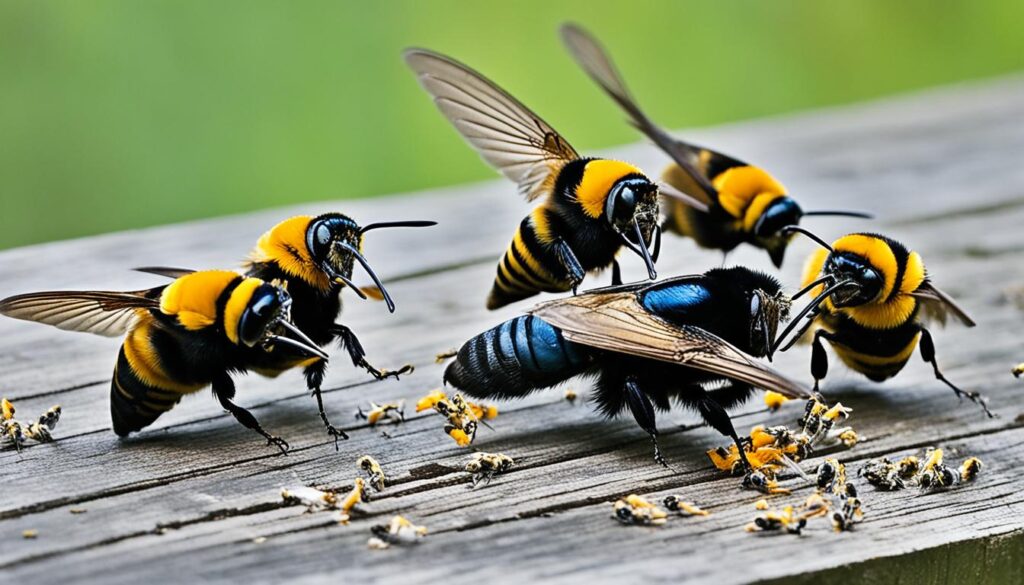

Good day! Do you know if they make any plugins to assist with SEO?
I’m trying to get my blog to rank for some targeted keywords but
I’m not seeing very good success. If you know of any please share.
Many thanks! You can read similar blog here: Wool product
Hey there! Do you know if they make any plugins
to assist with Search Engine Optimization? I’m trying to get my site to rank for
some targeted keywords but I’m not seeing very good results.
If you know of any please share. Thank you! I saw similar blog here:
Your destiny
I’m extremely impressed with your writing talents and also with the layout to your weblog.
Is this a paid theme or did you customize it your self?
Anyway stay up the nice high quality writing, it’s uncommon to look a nice blog like this one these days.
Stan Store!
I am extremely impressed along with your writing skills as well as with the
layout to your blog. Is that this a paid theme or did you customize it yourself?
Anyway keep up the excellent high quality writing, it’s rare
to look a nice blog like this one nowadays. Fiverr Affiliate!
I’m extremely impressed with your writing talents
as neatly as with the format for your blog.
Is this a paid subject or did you customize it yourself?
Either way keep up the excellent high quality writing, it’s uncommon to look a nice blog like this one these days.
Tools For Creators!